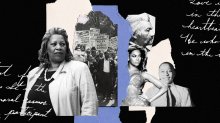Teaching Black History in Culturally Responsive Ways
Black history is American history, and it should be taught throughout the year across the curriculum—not confined to a single month.
As Black History Month kicked off, I was reflecting on my time as a student. My experience all those years ago was similar to that of most Black children today: mostly White teachers teaching Black history primarily in February.
I was told of Martin Luther King Jr., Harriet Tubman, and Frederick Douglass. I heard very little of Malcolm X, the FBI’s campaign against civil rights leaders, the Rainbow Coalition put together by the Black Panther Party’s Fred Hampton, or Hampton’s assassination. I learned about the struggles of my enslaved ancestors, but not about Gabriel Prosser, Denmark Vesey, or Nat Turner.
I was taught about the marches and firehoses in Alabama, but I had to teach myself about the acts of terrorism committed against Black people in Rosewood, Florida; Tulsa, Oklahoma; and Wilmington, North Carolina.
Today, teachers continue that tradition, telling students about Barack Obama, Oprah Winfrey, Beyoncé, and LeBron James, as well as King, Tubman, Douglass, and other inspirational figures. These folks are to be honored for their accomplishments—but we should not ignore lessons that explore the impact of racism in the Black experience. It’s imperative that teachers not reinforce a milquetoast version of Black history that is anti-Black because of its erasure of painful truths.
No matter what subject you teach, there are ways you can infuse Black history into your daily lessons in a way that is prophetic and purposeful.
Black History Is American History
Infuse Black history into the curriculum year-round: Tom Joyner, the recently retired syndicated radio host, used the phrase “Black history 365 days a year” to mean that Black history isn’t a gimmick meant for one month out of the year, with a student assembly or a potluck dinner with traditional Black foods. Black history is American history. Students should learn throughout the year and throughout all disciplines about the accomplishments, experiences, and perspectives of Black people.
How can teachers infuse Black history into their teaching? Here are some simple examples for core content areas:
- English: Provide students with texts—poetry and fiction, and nonfiction as well—written by Black people. Teach students about the Africanisms in American English when discussing or teaching grammar.
- Mathematics and science: Refer students to famous Black scientists and mathematicians throughout your course. Discuss how Black people showed an understanding of agricultural science in how they used soil in both West Africa and South Carolina to grow rice. Also, you can study the mathematical patterns of African art, and reference the rich history of math in sub-Saharan Africa in the areas of geometry, graphs, and numerical systems—you can engage students by playing African games like mancala that have a strong math component.
- Social studies: Incorporate primary and secondary source documents by or about Black people into student reading lists. Create an assignment in which students interview Black history scholars to discuss the Black experience in America throughout a social studies course.
Use texts by Black authors, in every discipline: In history class, I learned from textbooks written by White scholars. I read the works of Mark Twain, Charles Dickens, and William Shakespeare in English class, but never Langston Hughes, Maya Angelou, or Toni Morrison. According to a recent report, more than eight of every 10 books that New York City students are likely to see in class from preschool to eighth grade are written by White authors. Students should be introduced to texts by Black authors that speak to Black experiences, Black perspectives, and Black accomplishments. These authors remind children and adults that Black excellence is not confined to athletics and entertainment. How can we promote the academic excellence of Black children without introducing them to Black intellectuals—individuals they can see themselves someday becoming?
Teach students about important Black figures—especially local ones: Teaching about Obama and King is a good start, but you can introduce students to hidden figures as you work through your content during the school year.
If you’re a middle school science teacher and your students are interested in cultivating a community food garden, teach them about scientists like George Washington Carver, who developed methods to prevent soil depletion. If you’re an elementary teacher teaching students how to tell time, introduce them to Benjamin Banneker, who created the first American clock. Teaching students about important people is a great thing—even better is doing it in the context of your lessons, rather than in a set-aside month.
And if you teach students about the history of slavery in America, remember to include two topics in particular: the economics of slavery, and acts of resistance and rebellion by Black people. The enslavement of Africans built this nation’s economic foundation, and the entire nation benefited, so resistance and rebellion were met with brute force. Nevertheless, enslaved Africans and their enslaved descendants resisted through sabotage, running away, and outright rebellion and revolt—hundreds of revolts happened during African enslavement. Communities of formerly enslaved Black people along the East Coast fought to maintain their freedom and to free other enslaved people.
One task of teachers in the classroom is to acknowledge and honor students’ humanity—and that means acknowledging and honoring Black humanity. That starts with acknowledging the good, the bad, and the ugly of our history as a nation.
